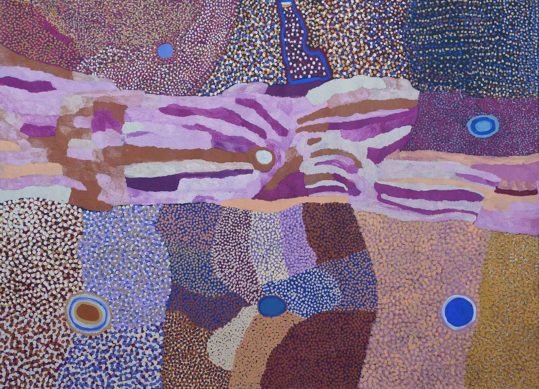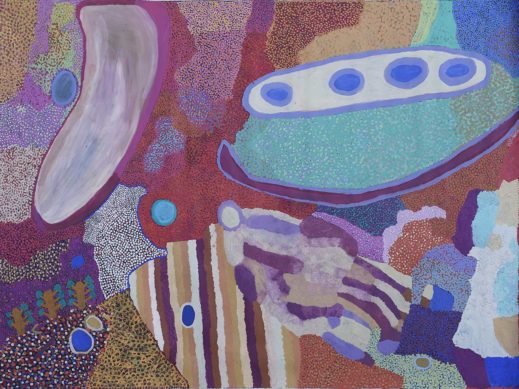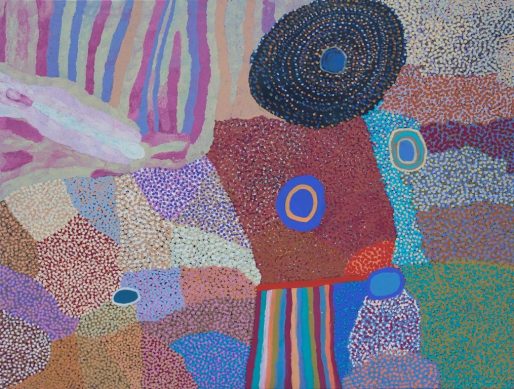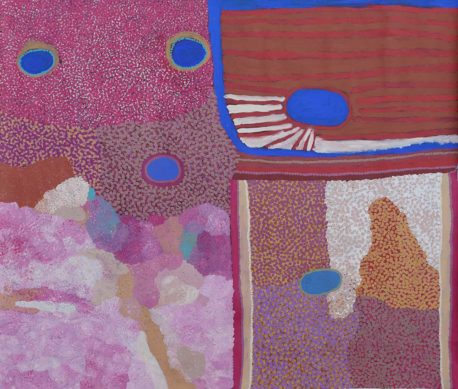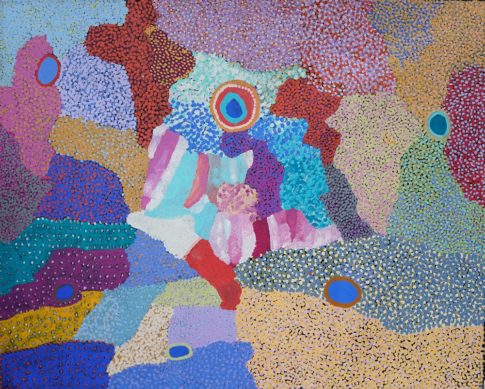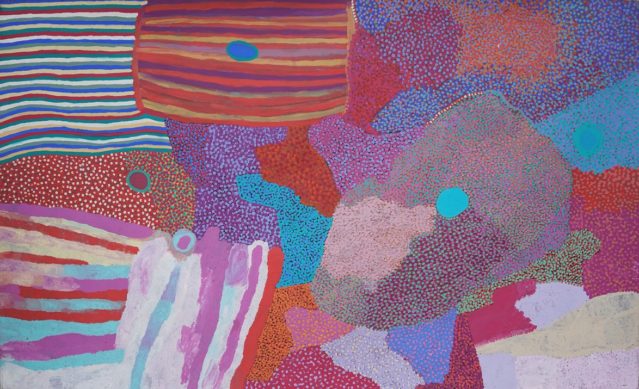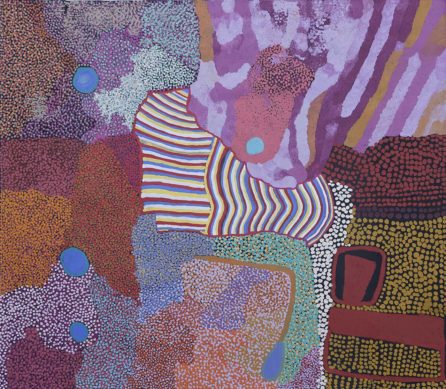Collaboration Wangkatjungka artists Paintings
Senior Wangkatjungka Artists collaborate to produce large paintings of their Ancestral Country on the Canning Stock Route
Collaborative paintings created at Wangkatjungka Community in the Kimberley between 2005 and 2010 represent the senior artist’s ancestral country and locations in the Great Sandy Desert. The majority of the participating artists grew up on their ancestral lands and were children when their parents joined the great exodus of families out of the Western Desert areas.
Wangkatjungka people had their first major contact with white men (kartiya) in 1906 when Canning led a survey team out into the desert to survey the track that was to link Wiluna in the south to Biluluna in the north. This track, the Canning Stock Route, passed right through Wangkatjungka country and had a great impact on the people. People started trading small quantities of flour, tea, tobacco, sometimes tinned meat. But desert people were amazed to see the amount of livestock that the survey team bought with them- hundreds of head of animals including goats, horses, mules and camels. Subsequent teams that came to build and maintain the stock route also bought large quantities of livestock with them.
Wangkatjungka people developed a taste for some European goods and for the abundance of meat that one livestock animal could provide. Several fatal conflicts occurred over the next twenty years over misunderstandings and false expectations about trading supplies. There were raiding parties among the Wangkatjungka people to steal livestock. But aboriginal skills with animals also lead to some Wangkatjungka men taking up the role as stockmen and during the 1920’s and 1930’s they began to travel the stock route to Bililuna Station.
Word got back to the desert about life on the cattle stations. They heard of secure water and food sources, about rations of white flour and sugar, tea and tobacco, woollen blankets. More people made the decision to move from their traditional lands towards areas of white settlement. Balgo Mission by this time had been established near Bililuna Station, at the northern end of the stock route. There had been a wider trend across central Australia for desert people to move towards mission settlements and government ration stations in response to land conflicts with cattle owners and with miners.
The desert was slowly beginning to lose population in the 1930’s and 1940’s from migrations to the margins of white settlement. Desert land management that required waterholes to be dug out from under sand drifts needed numbers of people to regularly carry out the tasks. The quantum number of people available dropped below reliable levels. Waterholes became buried and animal life also began to fall off. It became harder to survive in traditional lands.
Wangkatjungka people were moving north to cattle stations and to Balgo Mission. Many moved into cattle station country along the Fitzroy valley. During the wet season people gathered at Christmas Creek station for law and ceremony meetings. About the mid 1940’s a large group of families decided that they needed to move to the new settlements and travelled North West along a line of watercourses to Thangu Springs near Christmas Creek station. Encountering western diseases for the first time at Thangu Springs, an epidemic killed many people. Eventually the survivors were reunited with other relatives at Christmas Creek. Included in the group were many of the senior artists who worked on this canvas, who were children at the time.
The record of family ownership of groups of waterholes in the Great Sandy Desert is embedded in the knowledge and Dreaming law of Wangkatjungka people. Several waterholes (Nyirla and Kulyayi) were claimed by the Canning Stock Route builders and have had wells excavated next to them. Others are in more remote country and only knowledge by the traditional owners allows them to be mapped and connected to other waterholes. This painting can be seen as a statement of connection between the traditional owners and the “neighbourhood” of chains of waterholes that underpinned life for Wangkatjungka people of the Great Sandy Desert.
A selection of paintings by Wangkatjungka artists is available from Japingka Gallery, where collectors can buy Aboriginal art online with certainty of quality, authenticity and provenance of art works.
Exhibitions
2005 Wangkatjungka Artists: Stories from The Great Sandy Desert, Tandanya, National
Aboriginal Cultural Institute Adelaide SA
2006 Wangkatjungka Artists, Hogarth Galleries Sydney NSW
2007 Wangkatjungka Mapping Country, Japingka Gallery, Fremantle WA
2007 Desert Mosaic, Japingka Gallery, Fremantle WA
2008 Wangkatjungka Artists: Canning Stock Route, Japingka Gallery, Fremantle WA
2009 Desert Rains – Wangkatjungka Artists, Japingka Gallery, Fremantle WA
2010 Wangkatjungka Artists, Flinders Lane Gallery, Melbourne VIC
2010 Wangkatjungka Artists, Japingka Gallery, Fremantle WA
2013 I colori del deserto, Galleria Isarte (in collaboration with Japingka Gallery), Milan Italy
View Artists/h4>
Nada Rawlins
Rosie Goodjie
George Tuckerbox
Willie Kew
Biddee Baadjo
Stumpy Brown
Penny K Lyons

